
by Marco Lichtenberger
Among the oddball fishes frequently seen in the hobby is a family known as the
Spiny Eels. At first glance, they may appear like a cross-breed between an
anteater and a snake! Spiny Eels are distributed in Africa, as well as in
Southern and Eastern Asia. In contrast to many other eel-like fishes, which are
not closely related to them, they have pectoral fins that are often constantly
moving like a rotor of a helicopter. Especially their dart-like movement, their
ability to stop suddenly, and their habit of burying themselves in the substrate
until only their expectant eyes and strange trunk-like snouts are visible, make
them adorable pets. However, they have a bunch of specific requirements that
need to be known in order to keep them successfully for many years.
Species
The common name “Spiny Eels” comes from the spines found along their back. They
are not closely related to the true eels, but share a similar life style and
thus comparable appearance. There is quite a number of Asian spiny eels in trade
regularly. The designation of the different species to the most common genera
Mastacembelus and
Macrognathus is not always handled uniformly. It is best to employ the
species names for a first orientation. The nomenclature used in this text is
following the recent FishBase version of 2007. It is not uncommon at all that
the labels in the fish stores are wrong. Nonetheless, it important to know which
species you are actually buying. Although care is similar for all of them, their
maximum size varies drastically. A number of smaller species usually will attain
something around 20 cm (8 inches), while bruisers such as the "Zig-Zag Eel,
Mastacembelus armatus will reach 90 cm (35 inches) and consequently need
large tanks. A good indication on how large your future Spiny Eel will get is
its caudal (tail fin). The smaller Asian species (at least the ones commonly
traded) have a caudal fin separated from their dorsal and anal fins, while the
larger species have a continuous fin running around the end of the body not
unlike Moray Eel
Related to the popularity of African cichlids, the increase
of African spiny eels in the aquatic trade (e.g. Mastacembelus loennbergii),
which share the habitats of the cichlids, adds to the Spiny Eel confusion,
because they do not seem to obey the separate tail fin rule of their Asian
relatives. For the African species the genera Aethiomastacembelus,
Afromastacembelus and
Caecomastacembelus have been employed. Asking in the shop for the origin of
the eels thus may be useful, although it can be discussed how reliably such
information is. It always is a good idea to search the entire Mastacembelidae
(family of spiny eels) at
www.fishbase.org to get familiar with the typical coloration and markings of
the common species, instead of buying some spiny eels that will get larger than
the tank you thought they should live in.
Big species frequently seen in trade are the Fire Eel,
Mastacembelus erythrotaenia, the Tire Track Eel, Mastacembelus favus
and the Zig-Zag Eel,
Mastacembelus armatus. Among the smaller species you may be able to get your
hands on are Macrognathus aral, the Peacock Eel, Macrognathus
siamensis
and the Zebra Spiny Eel, Macrognathus zebrinus. Another
regularly-traded small species is Macrognathus pancalus, often not
recognized or confused with juvenile Mastacembelus armatus and other
species.
Macrognathus pancalus has numerous common names
such as "Striped Spiny Eel", "Barred Spiny Eel", "Zig-Zag Eel" (just like M.
armatus), "Yellow Fin Spiny Eel", "Indian Spiny Eel" and others. The typical
coloration can be observed on the pictures of this article. The overall darkness
of the fish and the actual amount of yellow in the coloration is variable,
though.
The species is common in India, Pakistan, Bangladesh and
Nepal. Aside its importance for the aquarium trade it is a very in-demand and
regionally pricey food, although it is a rather small species. The following
descriptions of proper husbandry are made for M. pancalus, but they may
be extended carefully to other small Asian Spiny Eels.
[pancalus00.jpg]
[pancalus04.jpg]
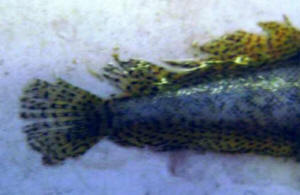 |
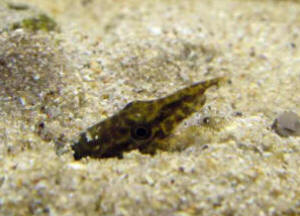 |
| The tail fin
of many small Asian Spiny Eel species is separated from their dorsal
and anal fins. |
If they bury
themselves, only the head sticks out of the substrate. |
Water Parameters
In nature M. pancalus occur in a wide range of water types. They are
abundant in flooded rice fields as well as in slow moving rivers and even
brackish water estuaries. Long-term husbandry experience confirms they can be
successfully kept in hard freshwater as well as in low (specific gravity approx.
1.005) to medium (specific gravity approx. 1.010) brackish water. Higher
salinities are probably disliked and may result in increased jumping.
A positive effect of brackish water seems to be that skin
abrasions, which the Spiny Eels regularly can get when trying to slip through
narrow rock gaps, do not infect and seem to heal faster than they do in soft
acidic water, in which fungus or bacterial infections may occur. Although no
white spot infection of M. pancalus seems reported, saltwater baths
should well be possible just in case.
A perfect compromise with regard to their natural biotopes
may be to keep them in lower end brackish tanks, but hard fresh water is equally
adequate.
M. pancalus accept a pH between
6 and 8, but might do best in neutral to alkaline water. Hard water is favoured
above fresh water. Temperature should be between 20 and 27°C (68 - 81 F). As in
all fish tanks nitrites and ammonia should be absent and nitrates should
constantly be kept low with regular water changes.
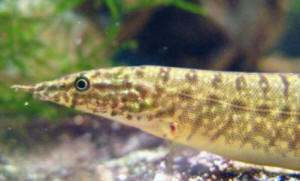 |
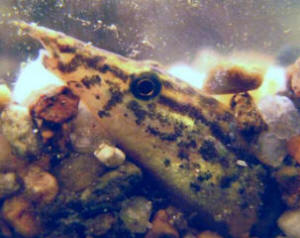 |
| Their body
is covered with tiny scales, and they do best in fine grained
substrates. |
Gravel is
also used to bury in, but should be rounded to avoid skin abrasions. |
Tank Setup
M. pancalus
attains a total length of 18 cm (7 inches). They should be kept in tanks not
smaller than 60 l (15 gallons). If they are supposed to share their tank with a
few other inhabitants, a 120 l (30 gallons) tank should be the minimum. If you
want to keep more than two, add about 15 gallons per additional Spiny Eel
because of their sometimes territorial behaviour.
Barred Spiny Eels are jumpers, as are many of their family members. A lid is
needed to prevent the fish from dying outside the tank. Filter inlets and
outlets should be secured with mosquito nets.
Spiny eels in general like to bury, only parts of their head and their typical
nostrils are sticking out of the substrate. The intensity of this behaviour may
be related to their tank mates, though. When first introduced to a new tank, a
pair of Barred Spiny Eels buried themselves immediately, but after several days
they stopped burying themselves. Since then, they preferred cavities in the
aquarium decoration as hiding spots and did not bury for several months. When a
new large Fiddler Crab was added to their tank, they seemed to be intimidated by
the more or less peaceful crab and started to bury again.
Planting will contribute to the comfort of the Spiny Eels as well as to the
water quality of the aquarium. Rooting plants will suffer under the digging
activities of the eels. It is possible to employ heavy flower pots perhaps in a
mosquito net to prevent the eels from digging inside the pot. In addition,
epiphytic plants, such as Java fern or Java moss can be used. Floating plants
also seem to be appreciated much by the eels.
The skin of the Spiny Eels is covered with small scales. However, they are prone
to skin diseases and infections especially at grazes they achieved during their
burying and hiding activities. Spiny Eels do best with sandy substrates.
Fine-grained gravel is also adequate if the grains are rounded. Avoid sharp
rocks, such as some lava rocks. Some eels will readily accept tank safe tubes
buried in the substrate and similar holes that can be created with rocks and
other pieces of decoration. Provide enough of these hiding spots to avoid
possible fights. When incorporating rocks, be careful not to use rocks with very
narrow holes in which the spiny eels can get stuck. Aside starving and jumping
out of the tank, it is not uncommon they die this way.
Spiny Eels are predominately nocturnal and can surprise you each morning with
their latest ideas on how to change the decoration of the tank. However, in calm
tanks they are also often visible during day time. Rarely they are chasing each
other, but most of the time they are sitting in their hideouts carefully
watching everything around them. Most activity can be observed if a specific
feeding time is kept.
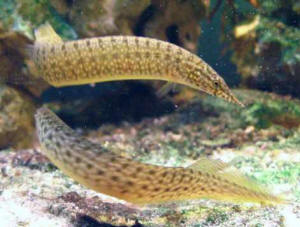 |
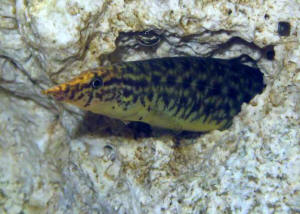 |
|
From time to time, Barred Spiny eels chase each other.
|
Holes in
limestone rocks are also used as hiding spots, but must not be too
narrow, because the eels can get stuck and eventually die. |
Feeding
Most of the dissected stomachs of wild-caught barred Spiny Eels were found
empty. That indicates they do not eat regularly in nature, and that feeding them
every other day or only once or twice a week may most resemble their feeding
habits in their natural habitat. Feeding them daily will help to train them to
be active during the day, though. They do not need much food and are easily
overfed, resulting in very lazy fat eels!
From aquarium observations, as well as from scientific
studies, it seems that M. pancalus are "stenophagic". That means they
have a diet consisting of only a few species in contrast to other fishes that
eat everything crossing their way. Spiny Eels can be considered picky eaters. In
nature insect larvae are reported to be their main food. They are supplemented
with annelids (earth worms and similar) and small crustaceans, as well as with
small fishes.
In tanks they often only eat live food for several weeks.
Readily accepted were live bloodworms, live blackworms, live Tubifex and
live earthworms collected from a toxin safe garden. In the long run only frozen
earthworms could be added to this diet, although a number of common training
methods e.g. not feeding for a week, dangling food on cotton strings and soaking
the food in dissolved vitamins were tried for about a year. That is why I
always keep a box of frozen earthworms, just in case live food is not on hand.
Other hobbyists have had more success and were able to feed their Barred Spiny
Eels with frozen bloodworms and Tubifex.
Spiny Eels are not forceful enough to compete with very
active species for food. Even a few Bumblebee Gobies are capable of eating away
most of a tank ration of live bloodworms before their eyes. If spiny eels are
kept in a community tank with active fish, it may be a good idea to feed them
with tweezers. Earthworms, in this case, are probably the best food for
practical reasons. In contrast, feeding live Tubifex or bloodworms with
tweezers, while trying to outrun a wild bunch of hungry fish, is a pain in the
neck. An advantage of feeding with tweezers is that you can ensure that everyone
gets something to eat.
Tankmates
M. pancalus
seem to be unable to rip out pieces of meaty food. So, any fish which does not
fit into their mouth should be safe. However, they are capable of nipping the
fins of other fishes. This bad habit only seems to occur with other Spiny Eels
of the same or other species, and may be interpreted as intraspecific aggression
or territoriality. Most likely the fin nipping will stop after some weeks, when
the territorial skirmishes have been settled. They never do much physical damage
anyway and the fins will grow complete again very fast.
Aside livebearer fry, they have not consumed other fish.
Anything at least as heavy as a large Bumblebee Gobies (beware there are very
small and larger species) is probably safe from the Spiny Eels, which leaves a
lot of possible tank mates for freshwater tanks and even a good number of fishes
for lower end brackish tanks. However, Spiny Eels should not be kept with
aggressive and predatory fish species or fin nippers. The lower-end-brackish
Puffer T. biocellatus (figure 8 puffer) seems to be a good tank mate, but
some individuals of this species will bother the Spiny Eels with fin nipping for
some time. Wrestling Halfbeaks are a group of species commonly available for
low-end-brackish tanks, which will not interfere much with the Spiny Eels.
Breeding
Because of the decreasing numbers of M. pancalus in the wild, hobbyists
should be encouraged to breed this species. A number of reports on the spawning
and rearing of fry, especially of M. pancalus, but also of other species,
exists. Unluckily, own experiences in breeding M. pancalus are
unavailable, yet.
It is not always easy to tell apart male and female Spiny Eels. Generally, the
females are larger, heavier and have a white belly, while the males are smaller,
more slender and have a more yellow belly. Females may also exhibit a larger
protruding anal tube, called urinogenital papilla, used to lay eggs. All
these characters are not foolproof, making it difficult to select male and
female specimens at a store.
A most interesting aspect with regard to keeping a number of
spiny eels together is that they seem to spawn in groups consisting of one
female and several males. Given their natural ratio of males and females is 1:1,
it seems the males may participate at several of these group spawnings in
nature. During courtship the males direct their snouts towards the gill area of
the female.
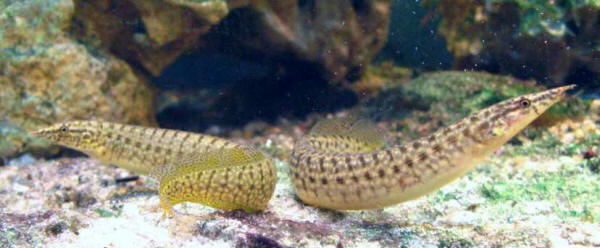 |
|
Macrognathus pancalus: female (right) and
male (left). |
The female attaches the sticky eggs to floating plants close
to the water surface. The eggs have a diameter of about 1 mm, tiny fry hatch
after 3 days. The parents do not care for the fry, which should be transferred
to a separate tank. They are swimming and drifting in the water column for about
one week and then begin their usual benthic mode of life on and in the
substrate. Following literature, they can be easily raised with live Artemia,
Daphnia and
Cyclops. In only 3 weeks they may reach a length of 3 cm and can be fed with
Tubifex.
Final Thoughts
The Barred Spiny eel, M. pancalus,
can be a nice fish for a fresh water or lower-end-brackish community tank. They
need a fine-grained substrate and have extravagant feeding preferences,
demanding live food or feeding with tweezers in most cases, but they are really
amusing oddballs, which will not cause much trouble given proper husbandry.
Literature
Karim M.A., Hossain A. (1972): Studies on the biology of
Mastacembelus pancalus (Ham.) in artificial ponds. Part II. Sexual maturity
and fecundity.- Bangladesh Journal of Biology and Agricultural Sciences, 1, p.
15-18.
Schoenebeck, K.-J. (1955): Haltung und Zucht von
Pfeilschnaebeln.- DATZ (Deutsche Aquarien und Terrarienzeitschrift), 8(1), p.
5-7 (in German).
Serajuddin, M. & R. Ali (2005): Food and feeding habits of striped spiny eel,
Macrognathus pancalus (Hamilton).- Indian Journal of Fisheries, 52(1), p.
81-86.
Swarup K., Srivastava S., Das V.K. (1972): Sexual dimorphism
in the spiny eel, Mastacembelus pancalus.-
Current Science, 41(2), p. 68-69.
